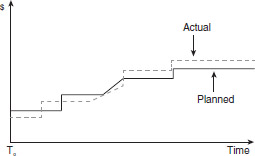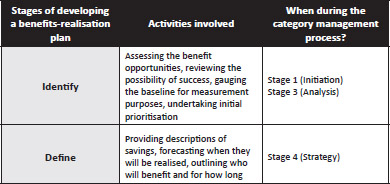Activity 30
Benefits realisation
Overview
Benefits realisation is the term used to assess the level of benefits (tangible or intangible) produced as a result of implementing a category management project. Measurement of identified benefits usually occurs after project closure but needs to be carefully considered and forecast in advance. Such planning activity is usually led by the category manager in conjunction with key stakeholders who agree upon the prioritisation and timings of each of the likely deliverables, culminating in a benefits-realisation plan (BRP).
The BRP serves as a useful management tool to monitor, track and manage the collective set of benefits. It is also a way of assigning ownership and accountability to individual team members so that performance can be targeted.
Elements
When developing a BRP, it is important that all those involved agree upon the definition of what constitutes a ‘benefit’. Popular terms used include the following:
- Direct savings – Often refers to a cost reduction, for example, where a newly negotiated price is less than what had previously been paid. If the purchase is new, then comparisons can be made against the prevailing market rate. This type of benefit may also include retrospective rebates or contract signing bonuses. Direct savings are easily quantifiable and contribute directly to a reduction in the ‘cost of goods sold’. Some refer to these as ‘bottom-line’ savings or ‘P&L savings’.
- Indirect savings – Sometimes referred to as a cost avoidance (i.e. avoiding costs that otherwise would have been incurred). Examples include negating additional insurance costs, reducing late-payment charges and avoiding price increases. These savings are valuable but do not make a positive contribution to improving the ‘bottom line’ and so are sometimes disregarded by finance experts.
- Efficiency savings – Enables cost reduction through improved effectiveness and efficiency, such as business process improvement, inventory reduction and elimination of waste. This type of savings can be harder to quantify, but every effort must be made to translate it into a financial form so that the category team can demonstrate the value the project has provided.
- Revenue generation – Where a category management initiative has helped the organisation increase its revenue income or generate new customers. These are primarily financial benefits but should be counted separately from any form of savings, as not all revenue is profitable.
- Added value – Other benefits are equally important but can take a ‘nonfinancial’ form. These should not be dismissed as ‘lesser’ benefits; from a stakeholder’s perspective, they could be more important. Typical examples include product innovation, service enhancement, risk reduction and quality improvement.
Project management authors frequently refer to a four-stage benefits-realisation process, as outlined in Figure 5.8.
So what?
BRP is a popular category management technique that provides clear roles and responsibilities together with facilitating alignment between project outcomes and business strategies. It is believed that accountability for realisation promotes the fulfilment of the deliverables.
Research has proved that pursuing a systematic and planned approach to benefits realisation increases the likelihood of project success. In particular, continual monitoring and review is vital, as benefits may materialise throughout the project cycle and will need to be captured in order to evidence a return on investment.
Category management application
- Supports the implementation stage of the category management process
- Clearly shows who is accountable for delivery of each benefit
- Provides an overview of the projected collective benefits, together with timescales
- Helps provide category project closure
- Provides evidence of category management success
Limitations
Identification of potential savings at the outset of the category management process is perceived as essential; however, the realisation of benefits tends to be a less formal approach. In large organisations, category managers can easily lose sight of their project at the implementation stage, once it has passed into the operational, ‘business-as-usual’ environment. This can lead to a lack of benefits ownership, especially if it involves benefits that could take years to be realised.
It is very easy for category managers and consultants to ‘overstate’ a prediction of future benefits, and so enthusiasm in this area may need to be supported with rigour. Best practice is to ensure that experts from the finance department are involved in the early identification of benefits so that an acceptable measurement and tracking system can be put in place by the category team.
Ideally, a ‘post-category project governance’ stage, often referred to as the ‘transformation committee’, should be established by the category manager, but in the thrust of the day-to-day business environment, this part of the category management process can be overlooked.
Template
The following template may be used to support the identification, monitoring and review of forecasted benefits resulting from the category management project:
- Template 30: Benefits-realisation plan


